Investigation on the Preparation and Performances of Epoxy-Modified Asphalt Binder and Its Mixtures
Abstract
1. Introduction
2. Experiment
2.1. Raw Materials
2.1.1. Modified Asphalt Binder Materials
2.1.2. Aggregates
2.2. Sample Preparation
2.2.1. Preparation of Epoxy-Modified Asphalt Binder
2.2.2. Aging Treatment of Epoxy-Modified Asphalt Binders
2.2.3. Preparation of Epoxy-Modified Asphalt Mixtures
2.3. Temperature Optimization for the Binder Preparation
2.3.1. Rotational Viscosity (RV) for Workability Evaluation
2.3.2. Tensile Test for Rating the Tensile Strength and the Elongation
2.3.3. Marshall Stability Test
2.4. Anti-Aging Performance and Microscopic Mechanism of Epoxy-Modified Asphalt Binder
2.5. Pavement Performance Investigation of Epoxy-Modified Asphalt Mixture
2.5.1. Rutting Test
2.5.2. Three-Point Bending Beam Test
2.5.3. Marshall Immersion Test
2.5.4. Fatigue Test
3. Results and Discussion
3.1. Reserve Time of Epoxy-Modified Asphalt Binder
3.2. Mechanic Performance of Epoxy-Modified Asphalt Binder
3.3. Marshall Stability Test of Epoxy-Modified Asphalt Mixture
3.4. Confocal Laser Scanning Microscopy Analyses
3.5. Technical Properties of Epoxy-Modified Asphalt Mixture
4. Conclusions
Author Contributions
Funding
Data Availability Statement
Conflicts of Interest
References
- Lo Presti, D. Recycled Tyre Rubber Modified Bitumens for road asphalt mixtures: A literature review. Constr. Build. Mater. 2013, 49, 863–881. [Google Scholar] [CrossRef]
- Xing, C.; Jiang, W.; Wang, M.; Zhao, K.; Li, Z. Minireview on the Rejuvenation of Aged Styrene–Butadiene–Styrene (SBS) Modified Bitumen: State-of-the-Art and Outlook. Energy Fuels 2023, 37, 7634–7647. [Google Scholar] [CrossRef]
- Huang, Y.; Wu, Z.; Liang, L.; Ying, J.; Gui, L.; Kang Shen, P.; Tian, Z.Q. Revealing the dependance of mechanical properties of asphalt binder on graphene size via multi-scale methods. Mater. Des. 2023, 236, 112478. [Google Scholar] [CrossRef]
- Wu, Z.; Huang, Y.; Gui, L.; Liang, L.; Ying, J.; Li, W.; Kang Shen, P.; Qun Tian, Z. 3D porous graphene nanosheets as efficient additives for high-performance styrene–butadiene–styrene/crumb rubber blend-modified asphalt. Mater. Des. 2023, 232, 112157. [Google Scholar] [CrossRef]
- Polacco, G.; Filippi, S.; Merusi, F.; Stastna, G. A review of the fundamentals of polymer-modified asphalts: Asphalt/polymer interactions and principles of compatibility. Adv. Colloid Interface 2015, 224, 72–112. [Google Scholar] [CrossRef] [PubMed]
- Xie, H.; Li, C.; Wang, Q. Thermosetting Polymer Modified Asphalts: Current Status and Challenges. Polym. Rev. 2023, 64, 690–759. [Google Scholar] [CrossRef]
- Chen, M.; Geng, J.; Xia, C.; He, L.; Liu, Z. A review of phase structure of SBS modified asphalt: Affecting factors, analytical methods, phase models and improvements. Constr. Build. Mater. 2021, 294, 123610. [Google Scholar] [CrossRef]
- Aldagari, S.; Karam, J.; Kazemi, M.; Kaloush, K.; Fini, E.H. Comparing the critical aging point of rubber-modified bitumen and plastic-modified bitumen. J. Clean. Prod. 2024, 437, 140540. [Google Scholar] [CrossRef]
- Zhao, Z.; Wu, S.; Xie, J.; Yang, C.; Yang, X.; Wang, F.; Liu, Q. Utilization of high contents desulfurized crumb rubber in developing an asphalt rubber pellet modified asphalt. Constr. Build. Mater. 2023, 402, 133043. [Google Scholar] [CrossRef]
- Lu, Q.; Bors, J. Alternate uses of epoxy asphalt on bridge decks and roadways. Constr. Build. Mater. 2015, 78, 18–25. [Google Scholar] [CrossRef]
- Sholar, G.A.; Page, G.C.; Musselman, J.A.; Upshaw, P.B.; Moseley, H.L. In Preliminary investigation of a test method to evaluate bond strength of bituminous tack coats. J. Assoc. Asph. Paving Technol. 2004, 73, 771–806. [Google Scholar]
- Li, K.; Xie, J.; Liu, Y.; Tan, Y.; Pan, Y. Development and evaluation of roadway-oriented epoxy-modified asphalt binders and mixtures. Constr. Build. Mater. 2024, 418, 135398. [Google Scholar] [CrossRef]
- Dongre, R.; Andriescu, A.; Elwardany, M.; Mensching, D.J.; Youtcheff, J. Exploration of Curing Characteristics of Epoxy-Modified Asphalt. Transp. Res. Rec. 2020. [Google Scholar] [CrossRef]
- Jing, R.; Apostolidis, P.; Liu, X.; Erkens, S.; Scarpas, T. First-Year Field Performance of Epoxy-Modified Asphalt. Transp. Res. Rec. 2023, 2677, 1110–1122. [Google Scholar] [CrossRef]
- Sun, J.; Zhang, Z.; Wang, L.; Liu, H.; Ban, X.; Ye, J. Investigation on the epoxy/polyurethane modified asphalt binder cured with bio-based curing agent: Properties and optimization. Constr. Build. Mater. 2022, 320, 126221. [Google Scholar] [CrossRef]
- Huang, W.; Qian, Z.; Chen, G.; Yang, J. Epoxy asphalt concrete paving on the deck of long-span steel bridges. Chin. Sci. Bull. 2003, 48, 2391–2394. [Google Scholar] [CrossRef]
- Kong, L.; Su, S.; Wang, Z.; Wu, P.; Zhang, Y.; Chen, Z.; Ren, D.; Ai, C. Microscale mechanism and key factors of waterborne epoxy resin emulsified asphalt enhancing interlayer bonding performance and shear resistance of bridge deck pavement. Constr. Build. Mater. 2024, 419, 135570. [Google Scholar] [CrossRef]
- Byzyka, J.; Davie, H.; Al-Kheetan, M.J.; Rahman, M. A Study on Cold Laid Microsurfacing Containing Water-Based Epoxy-Modified Bitumen Emulsion. Int. J. Pavement Res. Technol. 2023. [Google Scholar] [CrossRef]
- Cuadri, A.A.; Delgado-Sánchez, C.; Navarro, F.J.; Partal, P. Short- and Long-Term Epoxy Modification of Bitumen: Modification Kinetics, Rheological Properties, and Microstructure. Polymers 2020, 12, 508. [Google Scholar] [CrossRef]
- Lu, Q.; Xin, C.; Alamri, M.; Alharthai, M. Development of porous asphalt mixture with bio-based epoxy asphalt. J. Clean. Prod. 2021, 317, 128404. [Google Scholar] [CrossRef]
- Jing, R.; Apostolidis, P.; Liu, X.; Erkens, S.; Scarpas, T. Effect of mineral fillers on epoxy-modified open-graded porous asphalt durability. Int. J. Pavement Eng. 2023, 24, 2268799. [Google Scholar] [CrossRef]
- Qian, Z.-d.; Liu, Y.; Liu, C.-b.; Zheng, D. Design and skid resistance evaluation of skeleton-dense epoxy asphalt mixture for steel bridge deck pavement. Constr. Build. Mater. 2016, 114, 851–863. [Google Scholar] [CrossRef]
- Apostolidis, P.; Liu, X.; Kasbergen, C.; van de Ven, M.F.C.; Pipintakos, G.; Scarpas, A. Chemo-Rheological Study of Hardening of Epoxy Modified Bituminous Binders with the Finite Element Method. Transp. Res. Rec. 2018, 2672, 190–199. [Google Scholar] [CrossRef]
- Apostolidis, P.; Liu, X.; Marocho, P.; van de Ven, M.; Erkens, S.; Skarpas, T. Evaluation of epoxy modification in asphalt mastic. Mater. Struct. 2020, 53, 120. [Google Scholar] [CrossRef]
- Shi, S.; Chen, X.; Gu, L.; Ma, T. Investigated on hot mix epoxy resin used in steel bridge deck pavement affected by collaborative toughen. Case Stud. Constr. Mater. 2024, 20, e03019. [Google Scholar] [CrossRef]
- Jamshidi, A.; White, G.; Kurumisawa, K. Functional and field performance of epoxy asphalt technology—State-of-the-art. Road Mater. Pavement Des. 2023, 24, 881–918. [Google Scholar] [CrossRef]
- Mohammad, L.N.; Saadeh, S.; Qi, Y.; Button, J.W.; Scherocman, J. Worldwide State of Practice on the Use of Tack Coats: A Survey. J. Assoc. Asph. Paving Technol. 2008, 77, 1–34. [Google Scholar]
- Yan, Y.; Feng, J.; Guo, R.; Xiong, X. Research progress on compatibility of epoxy asphalt. New Chem. Mater. 2017, 45, 42–44. [Google Scholar]
- Feng, G.; Song, J.; Xue, X.; Xu, N.; Zhang, D.; Li, W. Curing kinetics of epoxy asphalt. Thermosetting Resin 2019, 34, 32–36. [Google Scholar]
- JTG E20-2011; Standard Test Methods of Bitumen and Bituminous Mixture for Highway Engineering, C.C.P. Standards Press of China: Beijing, China, 2011.
- Apostolidis, P.; Liu, X.; Erkens, S.; Scarpas, T. Oxidative aging of epoxy asphalt. Int. J. Pavement Eng. 2022, 23, 1471–1481. [Google Scholar] [CrossRef]
- JTG F40-2004; Technical Specifications for Construction of Highway Asphalt Pavements. Standards Press of China: Beijing, China, 2004.
- Zhang, H.; Zhang, G.; Han, F.; Zhang, Z.; Lv, W. A lab study to develop a bridge deck pavement using bisphenol A unsaturated polyester resin modified asphalt mixture. Constr. Build. Mater. 2018, 159, 83–98. [Google Scholar] [CrossRef]
- Ishaq, M.A.; Giustozzi, F. Correlation between Rheological Fatigue Tests on Bitumen and Various Cracking Tests on Asphalt Mixtures. Materials 2021, 14, 7839. [Google Scholar] [CrossRef] [PubMed]
- Aakif Ishaq, M.; Giustozzi, F. Correlation between rheological tests on bitumen and asphalt low temperature cracking tests. Constr. Build. Mater. 2022, 320, 126109. [Google Scholar] [CrossRef]
- Guo, Y.; Wu, H.; Shen, A.; Yang, X.; Cui, T. Study of the long-term water stability of asphalt mixtures containing steel slag aggregate. J. Adhes. Sci. Technol. 2020, 34, 877–902. [Google Scholar] [CrossRef]
- Wang, Q.; Min, Z.; Wong, Y.D.; Li, M.; Huang, W. Evaluation of properties and aging resistance of epoxy asphalt composite modified by ultraviolet absorber. J. Appl. Polym. 2023, 140, e53913. [Google Scholar] [CrossRef]
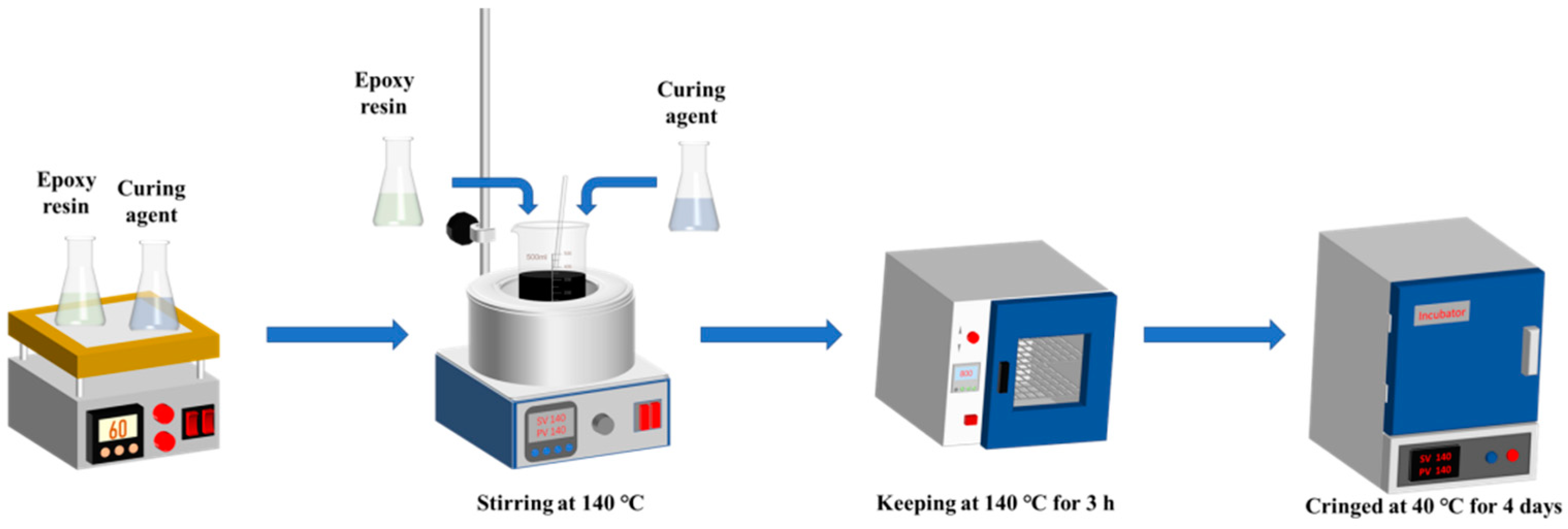
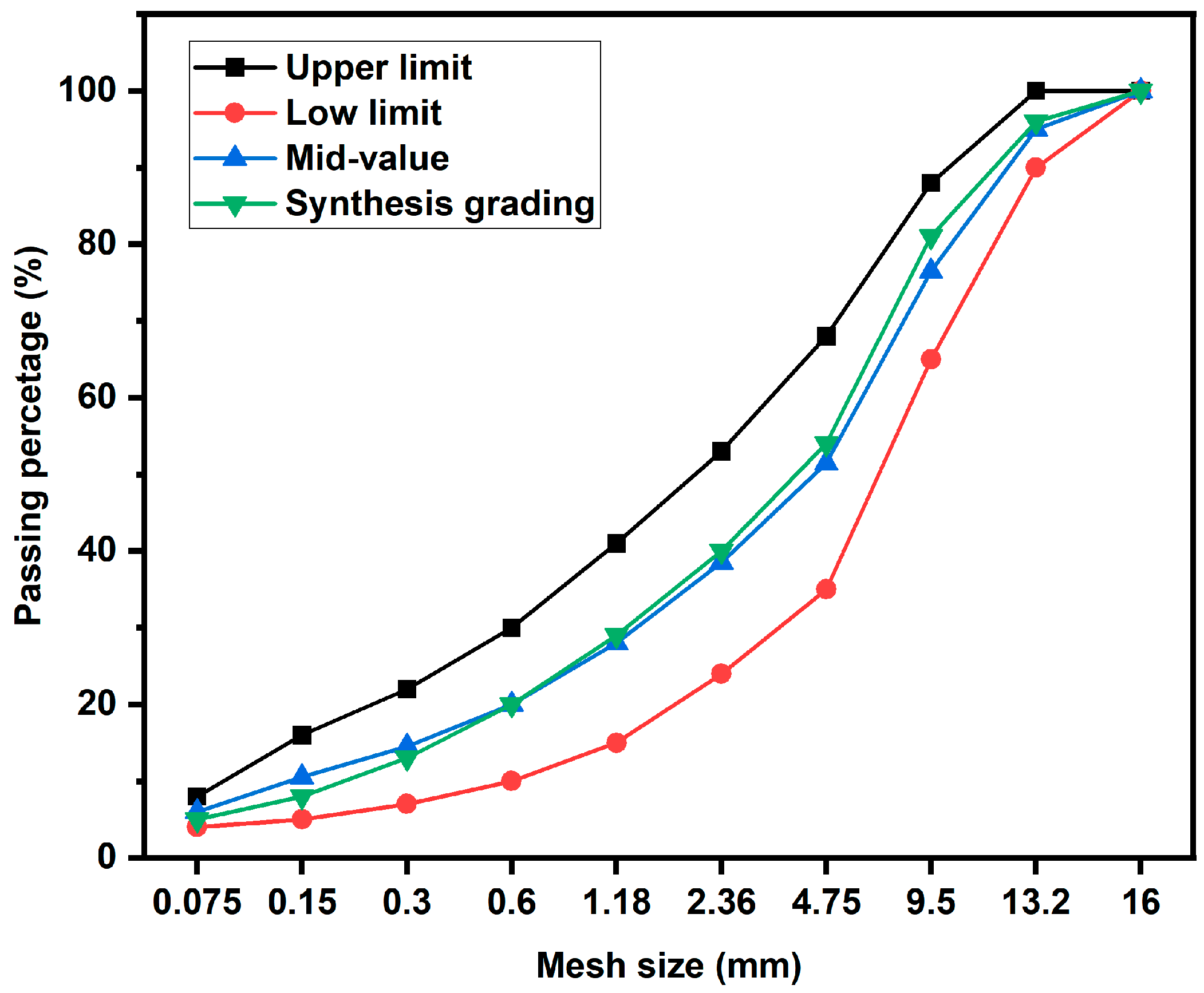
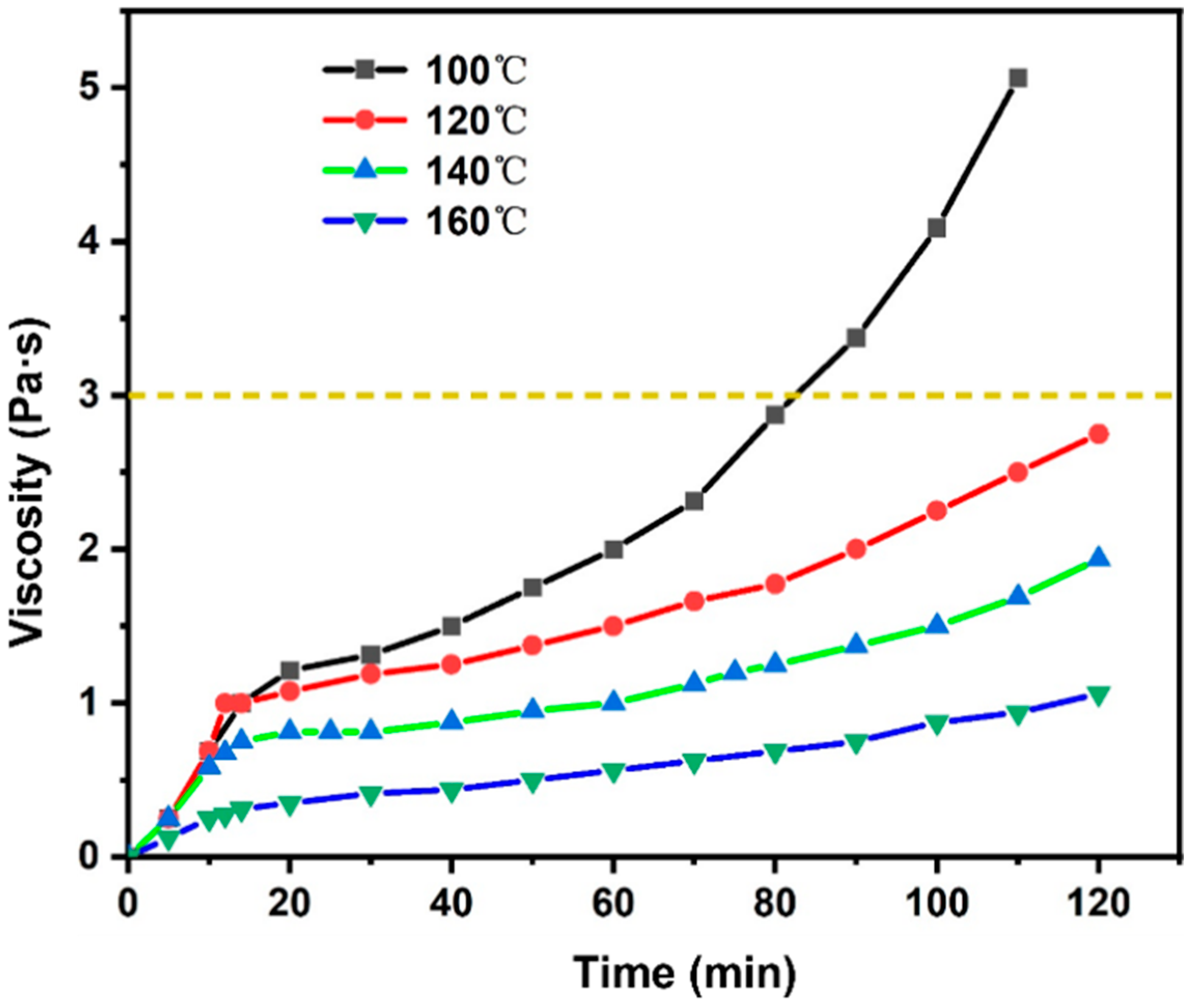

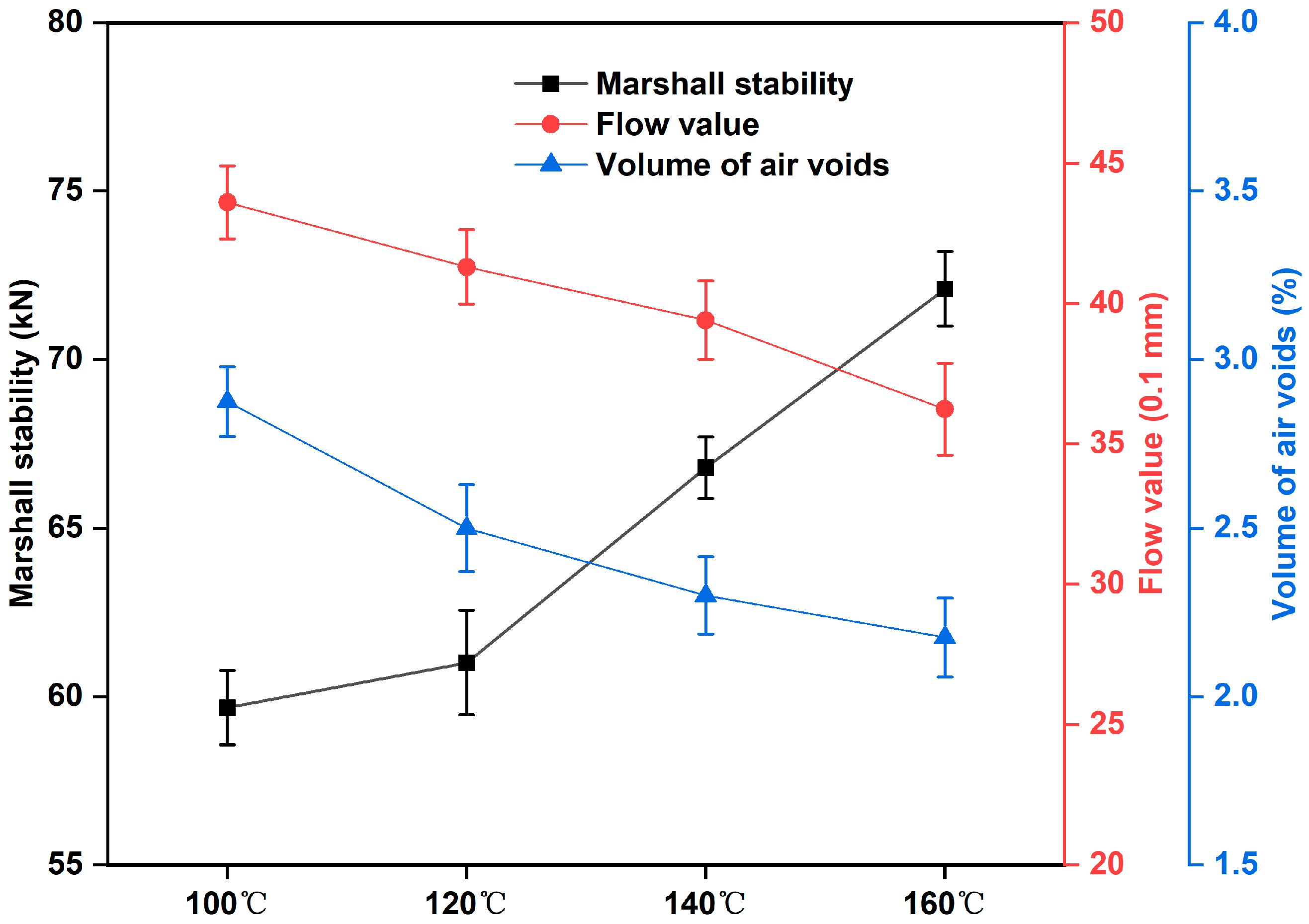

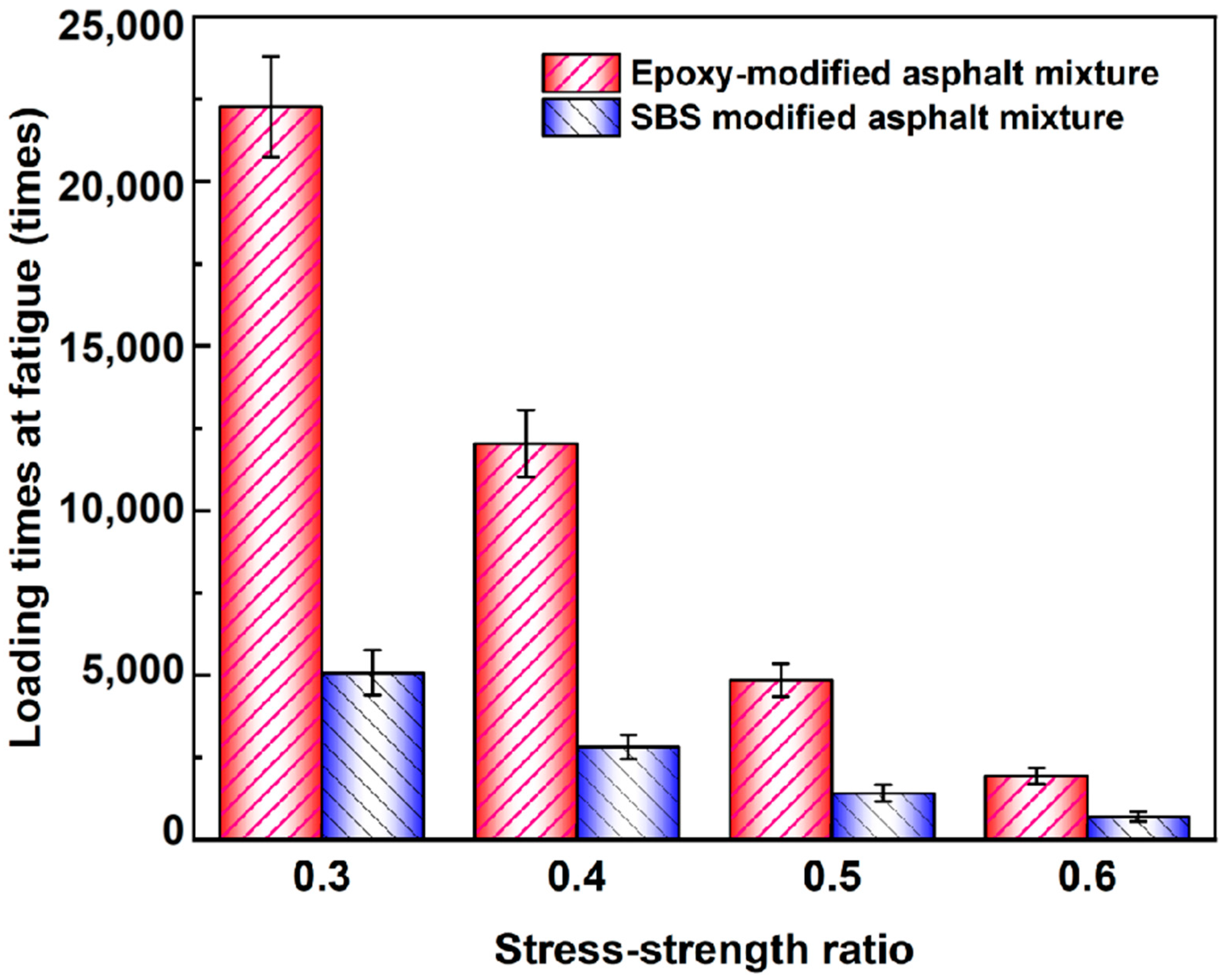
| Items | Technical Indexes | Results | Standard |
|---|---|---|---|
| Penetration (25 °C, 100 g, 5 s)/0.1 mm | 60–80 | 69 | JTG E20-T 0604 [30] |
| Softening point (°C) | ≥46 | 47.60 | JTG E20-T 0606 [30] |
| 60 °C dynamic viscosity (Pa·s) | ≥180 | 256 | JTG E20-T 0620 [30] |
| 15 °C ductility (15 °C, 5 cm/min)/cm | ≥100 | 165 | JTG E20-T 0605 [30] |
| Items | Technical Indexes | Results | Standard |
|---|---|---|---|
| Viscosity (Pa·s) | 11–15 | 14.66 | ASTM D1652 |
| Epoxy equivalent (g/ep) | 185~192 | 189 | ASTM D1084 |
| Items | Results |
|---|---|
| Crushing value (%) | 9–13 |
| Los Angeles abrasion loss (%) | 17.1 |
| Water absorption (%) | 0.6 |
| Apparent relative density (g/cm3) | 2.796 |
| <0.075 mm content (%) | 0.7 |
| Items | Results |
|---|---|
| Apparent relative density (g/cm3) | 2.644 |
| Angularity | 42.9 |
| Sturdiness (%) | 5–13 |
| Mud content (%), ≤ | 2.644 |
| Items | Results |
|---|---|
| Apparent relative density (g/cm3) | 2.770 |
| Water absorption (%) | 0.45 |
| Hydrophilic coefficient (%) | 0.62 |
| Plasticity index (%) | 2.56 |
| Rutting Test | Three-Point Bending Beam Test | Immersion Marshall | ||
|---|---|---|---|---|
| Rut Depth (mm) | DS (103 Cycle/mm) | σ0 (MPa) | ε (10−3) | RS (%) |
| 0.6 | 22,000 | 30.58 | 3.9 | 93.6 |
Disclaimer/Publisher’s Note: The statements, opinions and data contained in all publications are solely those of the individual author(s) and contributor(s) and not of MDPI and/or the editor(s). MDPI and/or the editor(s) disclaim responsibility for any injury to people or property resulting from any ideas, methods, instructions or products referred to in the content. |
© 2024 by the authors. Licensee MDPI, Basel, Switzerland. This article is an open access article distributed under the terms and conditions of the Creative Commons Attribution (CC BY) license (https://creativecommons.org/licenses/by/4.0/).
Share and Cite
Liu, X.; Wu, Z.; Min, Z.; Zhang, L. Investigation on the Preparation and Performances of Epoxy-Modified Asphalt Binder and Its Mixtures. Materials 2024, 17, 2539. https://doi.org/10.3390/ma17112539
Liu X, Wu Z, Min Z, Zhang L. Investigation on the Preparation and Performances of Epoxy-Modified Asphalt Binder and Its Mixtures. Materials. 2024; 17(11):2539. https://doi.org/10.3390/ma17112539
Chicago/Turabian StyleLiu, Xiaodong, Zhiheng Wu, Zhaohui Min, and Lei Zhang. 2024. "Investigation on the Preparation and Performances of Epoxy-Modified Asphalt Binder and Its Mixtures" Materials 17, no. 11: 2539. https://doi.org/10.3390/ma17112539
APA StyleLiu, X., Wu, Z., Min, Z., & Zhang, L. (2024). Investigation on the Preparation and Performances of Epoxy-Modified Asphalt Binder and Its Mixtures. Materials, 17(11), 2539. https://doi.org/10.3390/ma17112539





